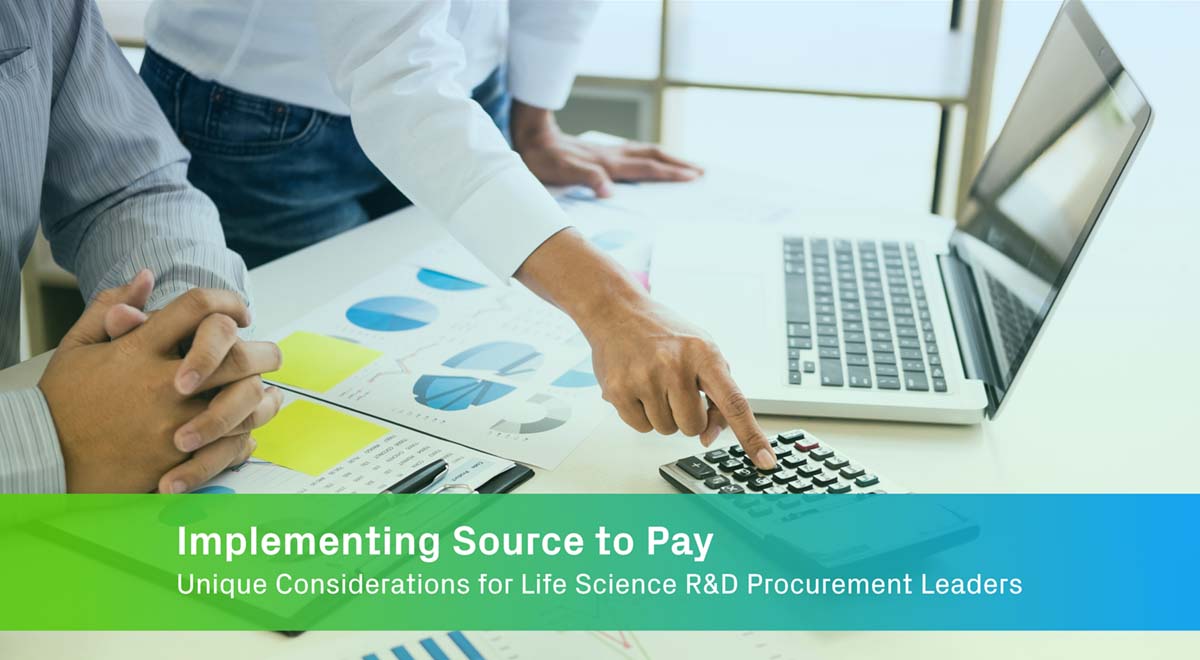Vetting and implementing a new spend management platform can be complex: from overseeing technical integrations with current technologies to working cross-functionally with departments to build out your holistic supplier strategy. Millions, if not billions, of spend is on the line, not to mention the additional individuals you’re paying to manage the spend. Adoption of a spring management platform may be yet another barrier as end users are often resistant to changing long standing behaviors and work streams.
You want to get started quickly in order to prove the benefits of the project as a part of your digital transformation initiative. It’s likely your organization already has Enterprise Resource Planning (ERP) software in place, and is looking to enhance this with the implementation of a procure-to-pay (P2P) system, following your purchases from requisition to payment. You may even go one step further with a source-to-pay (S2P) platform, which provides support from sourcing and contracting through purchasing and payment. With such systems, your goal is to provide complete supply chain consolidation in order to attain greater procurement efficiency.
While P2P and S2P promise to fully automate the purchasing process, there are purchasing challenges unique to life science R&D that prevent the ability to do so. Among these is the fact that experimental innovation requires unique products across a growing list of suppliers, which counters the procurement team’s focus on consolidation, creating efficiencies, and reducing costs. So, what’s the answer?
By taking advantage of a self-service eCommerce marketplace organizations can achieve full automation without limiting innovation.
A self-service marketplace, including category leaders and emerging suppliers, can simultaneously eliminate bottlenecks between suppliers and research scientists, lab managers, and procurement leaders, while creating efficiencies and value, reducing costs, and enhancing product development.
A marketplace solves three purchasing challenges unique to life science that could prevent procurement and scientific stakeholders from achieving their goals.
1. R&D Innovation Requires Substantial and Growing Tail-Spend
As you make your way through comprehensive spend analysis, something stands out. There are hundreds, perhaps thousands, of suppliers with minimal spend. Added together, these long-tail expenditures can make up almost half of your total R&D spend.
To get a better understanding, you ask the R&D director about the need for so many suppliers and for such infrequent purchases. You also inquire as to why these products can’t be purchased through the punchout catalogs you’ve set-up with the industry’s largest suppliers. Why? Because scientists are requiring a very specific product in order to achieve these novel experimental outcomes.
2. Lab Scientists Waste Hours Each Week on Purchasing Supplies
The R&D director explains the tremendous amount of time spent on protocol design alone; that running multiple, simultaneous experiments across key therapeutic areas requires unique products.
Scientists spend 4-8 hours per week searching website by website for their supplies, backorders are abundant, and order-tracking issues often delay experiments by weeks.
3. Vendor Spend Exceptions Cost Time and Money for All
The purchasing process is complicated enough, even when scientists order from the punchout catalogs. But, what about when a backorder occurs, or a unique component is needed? In cases like this, scientists are wasting hours trying to identify other, suitable vendors outside of the catalogs before submitting the order via the “free-text” feature in the P2P platform.
You realize that hundreds of orders are now going through this channel and your team is responsible for manually setting up each one - every new supplier account and every invoice, all while trying to holistically track the spend. You could outsource this to a third-party service, but that would only eliminate the actual product sourcing, which conflicts with your goals of consolidation, cost savings, and supplier relationship management. Scientists are still spending hours first finding the product, and adding a third-party to procure the item limits your visibility to pricing, ordering, and delivery.
What Do Scientists Want from the Purchasing Process?
You decide to do a brief survey with the scientists to find out exactly what they want. The results:
- One place to find any supplies they may need.
- Fast, consumer-like ordering with multi-supplier carts.
- Self-service access to order status and delivery.
- Easy way to find vetted alternatives for backordered items.
A Customer-Centric eCommerce Marketplace is a Win-Win for the Lab and Procurement.
With a self-service marketplace for R&D supplies, scientists spend less time finding products and more time at the bench.
Instead of combing the web, they can access tens of millions of product SKUs across thousands of suppliers, all in one place. Using the same tool, they can also track order status, find alternatives to backorders, and make sure their experiments are running on time.
With a self-service marketplace for R&D supplies, procurement spends less time managing suppliers, more time overseeing strategy, and realizes cost savings that can be reinvested into the all-important R&D function of the company.
Your procurement team no longer sets up new supplier accounts, benefits from a self-service tool to find alternatives if backorders arise, and has a way for scientists to oversee product statuses directly. Furthermore, their responsibilities are simplified through a consolidated invoice process and dashboard for a holistic, real-time view of the spend. They even have the ability to set cost savings targets and get discounts across previously unmanageable tail spend.
There’s no better way to accelerate innovation in life sciences R&D. ZAGENO’s eCommerce solution is a true alignment of business and science.
. . .
Notes:
Specifically, innovation in R&D requires niche product purchases which contribute to an ever-growing long tail. While these one-off purchases are small dollar, the hundreds if not thousands of purchases typically add up to up to half of all R&D spend, on average. As a result, procurement is tasked with manual processes to vet, process, and deliver these requests to their scientific stakeholders, not to mention setting up the supplier account when applicable. Thus, the vision of full automation cannot be achieved in R&D with a standard P2P or S2P system alone, and limiting scientific innovation is not an option.




